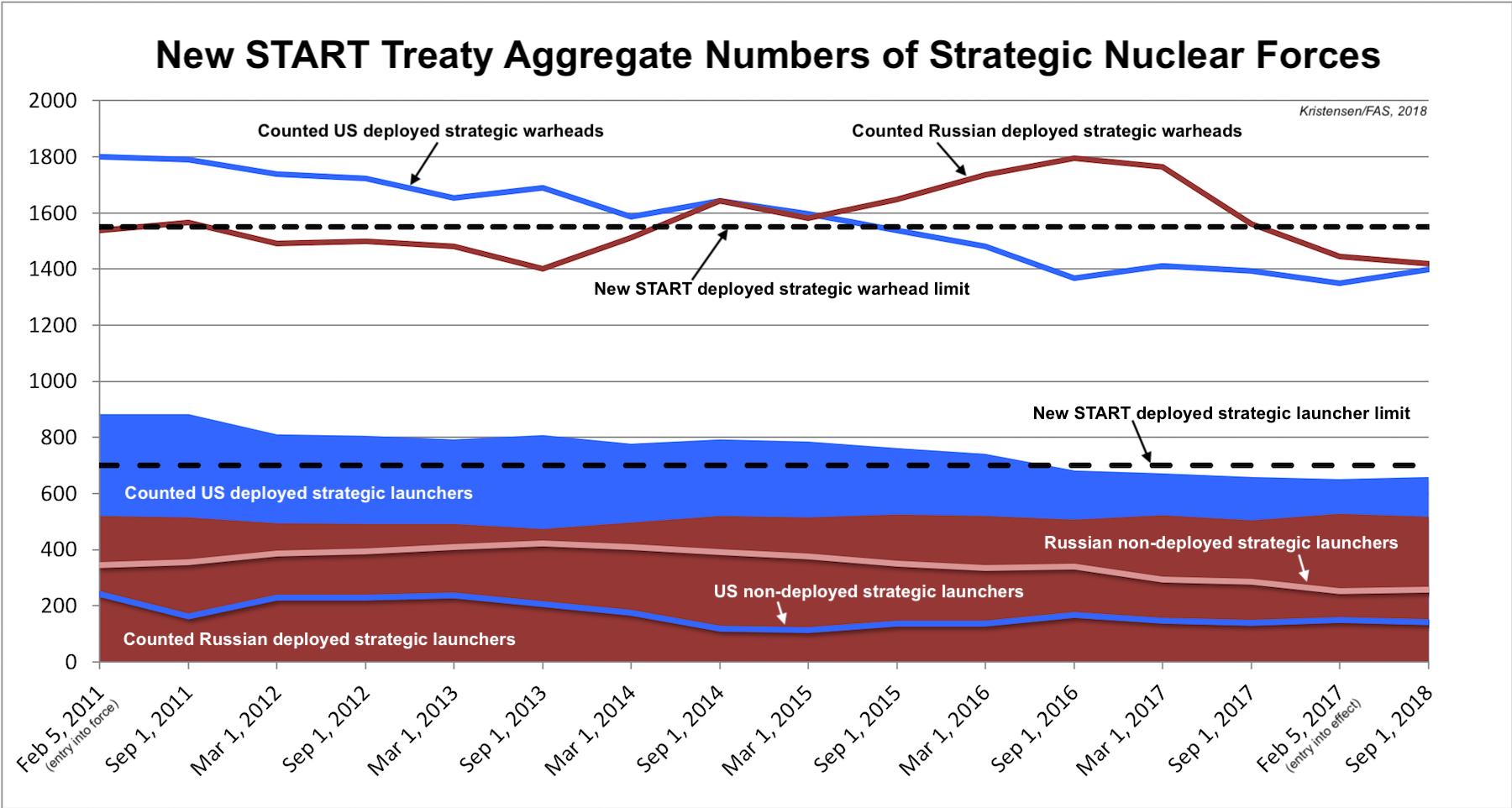New START Numbers Show Importance of Extending Treaty
By Hans M. Kristensen
The latest New START treaty aggregate numbers published by the State Department earlier today show a slight increase in U.S. deployed strategic forces and a slight decrease in Russian deployed strategic forces over the past six months.
The data shows that the United States and Russia as of September 1, 2018 combined deployed a total of 1,176 strategic launchers with 2,818 attributed warheads. In addition, the two countries also had a total of 399 non-deployed launchers for a total of 1,576 strategic launchers.
Combined, the two countries have reduced their deployed strategic forces by 227 launchers and 519 warheads since 2011.
The warheads counted by the New START treaty are only a portion of the total warhead numbers possessed by the two countries. The Russian military stockpile includes an estimated 4,350 warheads while the United States has about 3,800.
The release of the data comes at a particular important time when the United States and Russia are considering whether to extend the New START treaty for another five years beyond 2021 when it expires. The treaty is under attack from defense hawks in Congress and the Trump administration is weighing whether to extend New START in light of Russia’s alleged violation of other agreements.
The data reaffirms that Russia, despite its modernization program, is not increasing its strategic nuclear forces but continue to limit them in compliance with the limitations of New START. In our latest Nuclear Notebook on Russia forces, we estimate that the New START limits recently caused Russia to reduce the number of warheads deployed on several of its strategic missiles.
Deployed Warheads
The data shows that the United States as of September 1 deployed 1,398 warheads on its strategic launchers. This is an increase of 48 warheads since February. Since 2011, the United States has offloaded 402 attributed warheads from its force.
The 1,398 is not the actual number of warheads deployed because bombers are artificially attributed one weapon each even though they don’t carry any weapons in peacetime. The actual number of deployed warheads is closer to 1,350.
Russia was counted with 1,420 deployed strategic warheads, a reduction of 24 warheads from February, and a total of 117 attributed warheads offloaded since 2011. Russian bombers also do not carry weapons so the Russian number is probably closer to 1,370 deployed strategic warheads.
These changes don’t reflect one country building up and the other reducing its forces, but are caused by fluctuations when launchers move in and out of maintenance or old launchers are retired or new ones added.
Deployed Launchers
The data shows the United States deployed 659 strategic launchers, an increase of 7 since February, and a total reduction of 223 launchers since 2011.
Russia deployed 517 strategic launchers, 142 fewer than the United States. That is 10 launchers less than in February, and a total reduction of 4 launchers since 2011.
Non-Deployed Launchers
The data also shows how many non-deployed launchers the two countries have. These are either empty launchers that are in reserve or overhaul or have not yet been destroyed.
The United States had 141 non-deployed launchers, which included empty ICBM silos, bombers in overhaul, and empty missile tubes on SSBNs in overhaul or refit. Since 2011, the United States has destroyed 101 non-deployed launchers.
Russia was counted with 258 non-deployed launchers. This includes empty ICBM silos, empty missile tubes on SSBNs in overhaul, and bombers in overhaul. Since 2011, Russia has destroyed 86 non-deployed launchers.
Essential Verification In Troubled Times
The treaty includes an important verification system that requires the United States and Russia to exchange vast amounts of data about the numbers and operations of their strategic forces and allows them to inspect each other’s facilities.
Since the treaty entered into effect in 2011, the two countries have exchanged 16,444 notifications about launcher movements and telemetry data; 1,603 since February this year.
Data released by the State Department shows that U.S. and Russian inspectors have conducted a total of 277 on-site inspections of each other’s strategic forces and facilities since the treaty entered into force in 2011. So far this year, U.S. officials have inspected Russian facilities 13 times compared with 12 Russian inspections of U.S. facilities.
The combined effects of limiting deployed strategic forces and the verification activities requiring professional collaboration between U.S. and Russian officials, mean that the New START treaty has become a beacon of light in the otherwise troubled relations between Russia and the United States, far more so than anyone could have predicted in 2010 when the treaty was signed.
Other background information:
- Russia nuclear forces, 2018
- US nuclear forces, 2018
- Status of world nuclear forces, 2018
- After Seven Years of Implementation, New START Treaty Enters Into Effect
This publication was made possible by a grant from the Carnegie Corporation of New York, the John D. and Catherine T. MacArthur Foundation, the New Land Foundation, and the Ploughshares Fund. The statements made and views expressed are solely the responsibility of the author.
The Federation of American Scientists applauds the United States for declassifying the number of nuclear warheads in its military stockpile and the number of retired and dismantled warheads.
North Korea may have produced enough fissile material to build up to 90 nuclear warheads.
Secretary Austin’s likely certification of the Sentinel program should be open to public interrogation, and Congress must thoroughly examine whether every requirement is met before allowing the program to continue.
Researchers have many questions about the modernization of Pakistan’s nuclear-capable aircraft and associated air-launched cruise missiles.
